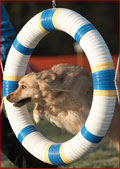Studies Show That Dogs Read Human Gestures Like 2 Year Old Children
Dogs possess a two-year-old child's capacity to understand human pointing gestures, with dogs requiring next to zero learning time to figure out the visual communication, according to two recent studies.
The comparison with kids doesn't end there. Due to domestication, dogs appear to be predisposed to read other human visual signals, including head-turning and gazing.
Pet owners often use baby talk, scientifically known as "motherese," with both children and dogs, allowing canines and kids to receive similar social stimulation.
Since chimpanzees and other non-human primates often flunk pointing gesture tests, the studies suggest dogs may understand humans better than even our closest living animal relatives do.
"The human pointing gesture is cooperative in its nature," Gabriella Lakatos told Discovery News. Lakatos, a researcher in the Department of Ethology at Eotvos University, led the first study, published in the current issue of Animal Cognition.
She explained that other recent studies suggest chimpanzees "might have difficulties with comprehending situations based on cooperation," mentioning "the observation that chimpanzees do not actively share food." Dogs, on the other hand, often eagerly cooperate.
For her study on dogs and kids, Lakatos and her colleagues used a combination of finger-, elbow-, leg- and knee-pointing gestures to help dogs locate hidden food and, for children, a favorite toy.
Two-year-olds and dogs understood everything except knee-pointing and when the experimenter's index finger pointed in a different direction than the protruding arm. For example, they were confused when the individual raised an arm in a certain direction, but used her finger to point the other way.
Human three-year-olds, on the other hand, aced all of the tests.
Lakatos said that "in human children between the age of two and three years, important changes take place that go beyond the capacities of dogs." Many of these changes have to do with development of language skills.
"The ability to generalize in children makes the precision of gesturing by the adult less important," she added. "Children may have a more complex ability to realize the intention behind the pointing gesture."
When gesturing to a dog or child under three, it's therefore best not to fidget or otherwise move in confusing ways.
"Our results show that dogs can understand the pointing gesture if a body part protrudes from the body silhouette," Lakatos said.
For the second study, published in the prior issue of the same journal, Marta Gacsi, also of Eotvos University, and her team analyzed 180 dogs of various ages to see how development and individual differences affect their understanding of human pointing.
Studies Show That Dogs Read GesturesGacsi and her colleagues determined "the dogs showed no difference in the performance according to age, indicating that in dogs the comprehension of the human pointing may require only very limited and rapid early learning to fully develop."
Lakatos cautions, however in thinking that dogs are just like furry two-year-old children.
"Any behavioral similarity or similar performance between dogs and children should be investigated separately in each case," she advised. "Just to give an example for a reverse case: nobody has tried to herd a flock of sheep with two-year-old (human children)."
From:Discovery.com







 Ontario Dog Sports
Ontario Dog Sports
Reader Comments